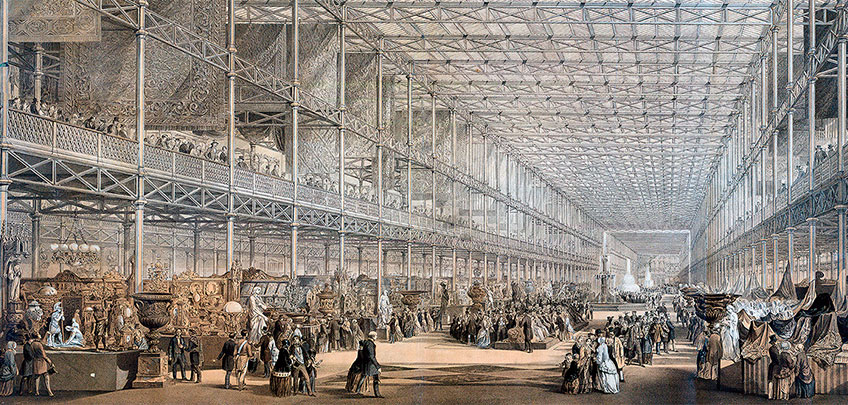Since 1851, Expos have helped humanity make sense of change and chart a more progressive future by gathering people and nations under the common banner of Education, Innovation and Cooperation. As mirrors of their time, Expos have always served to reflect evolving priorities and worldviews, all while anticipating a future shaped by technological progress. From their earliest manifestations as a showcase of industrial prowess to their modern incarnation as platforms for cross-border collaboration, Expos have transformed cities, shaped debates on key issues, and provided unforgettable experiences to hundreds of millions of visitors.
Birth of a concept: The Great Exhibition of 1851
Prince Albert, consort to Queen Victoria of the United Kingdom, spearheaded ‘The Great Exhibition of the Works of Industry of all Nations’, which was held in the custom-built Crystal Palace between May and October 1851. Reflecting the rapid changes of the industrial revolution, the very first World Expo was a unique gathering of nations, showcasing material progress based on technological innovation. By bringing together the best and most advanced creations from around the world, the Expo fostered a form of peaceful competition, but moreover sought to encourage the exchange of ideas and inspire visitors.
Showcasing progress in a changing world
The concept – educating the public, promoting exchange and exhibiting new ideas and products – proved popular and was readily repeated across the world. In particular, France organised five Expositions Universelles in Paris between 1855 and 1900, consolidating the establishment of Expos as the most important events of cultural exchange, and as major diplomatic and economic gatherings. The growing recognition and importance of Expos gave rise to the flourishing development of international congresses and conventions leading to stronger cross-border cooperation in fields as varied as intellectual property, labour rights, sport, and education.
Expos became the foremost events for showcasing new technologies and inventions, and for realising architectural and technical feats, such as the Eiffel Tower or moving walkways. In turn, they became the ideal venues for nation branding, giving countries the opportunity to promote their art, culture and engineering accomplishments. The emergence of recognisable country pavilions starting with the façades of the Rue des Nations in the French Expos exemplified the beginnings of this growing form of public diplomacy.
The multiplication of Expos organised under different rules and with different focal points led to the idea of setting up a common organisational framework. This project, first mooted by Germany in 1913, eventually came to fruition in Paris in 1928, when 31 countries signed the Convention relating to international exhibitions. The Convention defined Expo types, their duration and their frequency, established a regulatory procedure for host and participant countries, and created a governing body to apply the Convention: the Bureau International des Expositions (BIE).
Dawn of a new era
The impact of World War II and its aftermath changed the focus of Expos: the fascination for material progress gave way to the promotion of quality of life and international dialogue. Technology was still at the centre of Expos, but as a means of promoting human development rather than as an end in itself. By creating a platform for discussion and by showcasing ideas and inventions in favour of better lives, Expos became global platforms for exchange and discussion. The evolving themes of the Expos from the 1950s onwards demonstrated this shift, including “Progress and Mankind” at Expo 1958 Brussels, or “Man and his World” at Expo 1967 Montreal.
At the same time, the process of decolonisation led to an increase in the number of independent nations and therefore participants in Expos. From 39 countries participating in Expo 1958, the number of participating countries continued to grow, reaching 155 at the turn of the century with Expo 2000 Hannover. This evolution had the effect of broadening the scope of Expos to encompass wider perspectives, giving all countries an equal chance to shape the debate, showcase their solutions and project soft power in an increasingly globalised and interconnected world.
Building a better future
These global challenges were explicitly tied with Expos when, in 1994, the BIE General Assembly adopted a resolution guaranteeing that all Expos have “a commitment to the supreme importance for Humanity of due respect for Nature and the environment”. This principle - highlighted at Expo 2000 Hannover through “Man, Nature, Technology” – is a focus of all modern-day Expos, which address global challenges through the lens of sustainability.
In the 21st century, participation in Expos has been widened to include civil society, cities and regions, and international organisations. Through thematic forums – and, starting with Expo 2010 Shanghai, Best Practice areas – ideas, solutions and technologies from across the world are showcased to encourage international exchange.
Today, by providing a unique space for cross-cultural cooperation, Expos serve as transformational instruments of progress in all areas of human life and endeavour. In the past 170 years, the format and scope of Expos has evolved and adapted, reflecting changing political, economic and social currents. Moving with their time since 1851, Expos are a link between the past, the present and the future, promoting the same values and goals of gathering the world in favour of progress for all.




